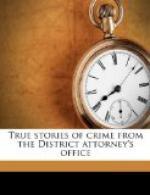“Just flash a few letters on him,” said the girl. “Letters and envelopes.”
“Where do you get ’em?” asked Peabody.
“Just write them, silly, and send them to yourself through the mail.”
“That’s all right,” retorted the “second story man.” “But how can I mail myself a letter to 100 West One Hundredth Street when I don’t live there?”
Mrs. Parker smiled in a superior manner.
“I’m glad I can put you wise to a new game, I invented it myself. You want letters of identification? In different names and addresses on different days? Very good. Buy a bundle of stamped envelopes and write your own name and address on them in pencil. When they arrive rub off the pencil address. Then if you want to be John Smith of 100 West One Hundredth Street, or anybody else, just address the cancelled envelope in ink.”
“Mabel,” said Peabody with admiration, “you’ve got the ‘gray matter’ all right. You can have me, if you can deliver the rest of the goods.”
[Illustration: Fig.3.—A letter-head frill of Mabel Parker’s.]
“There’s still another little frill,” she continued, pleased at his compliment, “if you want to do the thing in style. Maybe you will find a letter or bill head in the mail at the same time that you get your sample check. If you do, you can have it copied and write your request for the check book and your order for the goods on paper printed exactly like it. That gives a sort of final touch, you know. I remember we did that with a dentist named Budd, at 137 West Twenty-second Street.” (Fig. 3.)
“You’ve got all the rest whipped to a standstill,” cried Peabody.
“Well, just come over to the room and I’ll show you something worth while,” exclaimed the girl, getting up and paying their bill.
“Now,” said she, when they were safely at no West Thirty-eighth Street, and she had closed the door of the room and drawn Peabody to a desk in the bay window. “Here’s my regular handwriting.”
She pulled towards her a pad which lay open upon the desk and wrote in a fair, round hand:
“Mrs. James D. Singley.” (Fig. 4.)
“This,” she continued, changing her slant and dashing off a queer feminine scrawl, “is the signature we fooled the Lincoln National Bank with—Miss Kauser’s, you know. And this,” she added a moment later, adopting a stiff, shaky, hump-backed orthography, “is the signature that got poor Jim into all this trouble,” and she inscribed twice upon the paper the name “E. Bierstadt.” “Poor Jim!” she added to herself.
“By George, Mabel,” remarked the detective, “you’re a wonder! See if you can copy my name.” And Peabody wrote the assumed name of William Hickey, first with a stub and then with a fine point, both of which signatures she copied like a flash, in each case, however, being guilty of the lapse of spelling the word Willia_m_ “Willia_n_.”




